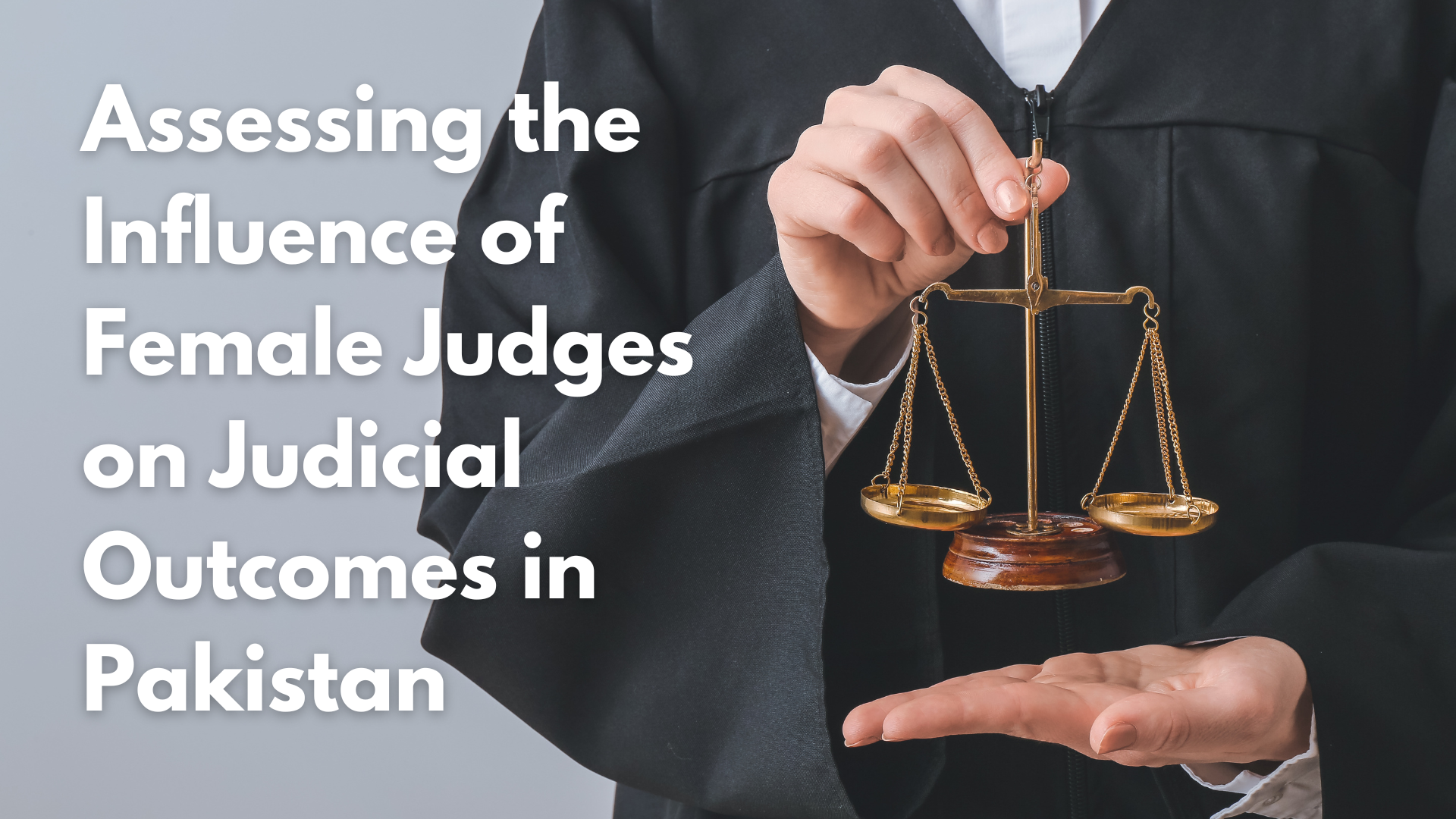NEWS

IN BRIEF

Written by: Ayesha Khan
The representation of women in Pakistan's judiciary is alarmingly low, particularly at senior levels, raising concerns about the impact of gendered justice on judicial outcomes. This analysis explores the status of female judges, their influence on decision-making, and the societal consequences of their underrepresentation.
SHARE
Introduction
The representation of women in Pakistan’s judiciary is alarmingly low, particularly at senior levels, raising concerns about the impact of gendered justice on judicial outcomes. This analysis explores the status of female judges, their influence on decision-making, and the societal consequences of their underrepresentation.
Addressing gender imbalance is vital for a fair legal system. Increasing the number of female judges can enhance judicial outcomes by incorporating diverse perspectives that reflect women’s societal challenges. However, this requires systemic reforms to support women’s entry and retention in the judiciary and initiatives to challenge societal norms that hinder women’s role in law.
Achieving gender equality in the judiciary is essential for upholding democratic values and ensuring equitable treatment for all citizens. Therefore, collaboration among government entities, legal institutions, and civil society is crucial to promoting gender inclusivity in Pakistan’s judicial system.
Current Landscape of Female Judges in Pakistan
The representation of women in Pakistan’s judiciary is alarmingly low, particularly in higher courts. A recent Law and Justice Commission of Pakistan (LJCP) report shows that only 7 out of 126 judges in the superior judiciary are women, making up just 5.5% of the total. This reflects broader societal issues regarding gender equality and systemic barriers faced by women in law.
However, there are 3,142 judges and judicial officers in Pakistan, with 572 being female, or 18% of the workforce. However, this figure masks significant disparities, the Supreme Court has only 2 female judges among 12, the Sindh High Court has 3 out of 30, and the Islamabad High Court has 1 out of 8. Alarmingly, there are no female judges in the Federal Shariat Court, Peshawar High Court, or Balochistan High Court.
The underrepresentation extends to lawyers as well, with only about 40,000 women among approximately 230,879 registered lawyers, or roughly 17% of the profession. However, the gender gap is exacerbated by a lack of supportive frameworks and mentorship for women in the legal field.
The underrepresentation of women in Pakistan’s judiciary reflects deep-rooted societal attitudes and systemic challenges. The patriarchal mindset often undermines women’s capabilities, leading to doubts about their suitability as judges.
On the other hand, limited access to legal education and career advancement due to societal norms and discrimination. Moreover, the lack of female role models in high-ranking judicial positions discourages aspiring female lawyers. Harassment and misogyny in legal environments, deter women from entering or staying in the profession. The LJCP report emphasizes that addressing these barriers requires coordinated efforts from government and civil society to promote gender inclusivity in the judiciary.
The lack of female representation in Pakistan’s judiciary has serious implications for gender equality and justice. A male-dominated judiciary may overlook women’s rights issues, resulting in inadequate legal protections for vulnerable populations. Additionally, the absence of women judges can marginalize women’s perspectives in legal discussions, hindering progress toward women’s empowerment with equality.
Impact on Judicial Outcomes
The insertion of female judges in Pakistan’s judiciary significantly impacts judicial outcomes, especially on gender-sensitive issues. While women’s representation remains limited, there is a gradual increase in female judges, particularly in family courts, which is crucial for interpreting laws related to women’s rights and gender equality.
Research shows that female judges bring unique perspectives that positively influence decision-making in cases involving women, often supporting victims of domestic violence and sexual assault. Their experiences allow for a sensitivity that may be lacking among male judges. Currently, female judges make up over one-third of family courts, reflecting a commitment to gender equality as per international treaties ratified by Pakistan.
Moreover, the nomination of women judges promotes cultural change within the judiciary, challenging norms that have historically undermined women’s rights. Their presence encourages more equitable legal interpretations and a stronger focus on protecting women’s rights in legal proceedings.
Despite advancements, the impact of female judges on judicial outcomes varies by court level. Women in these roles face significant obstacles, including systemic biases and institutional challenges that can limit their effectiveness. Many are assigned to family courts, often seen as less prestigious, which can undermine their authority. Additionally, societal perceptions can lead to skepticism about their abilities, pressuring them and restricting their decision-making independence. Even in high-ranking positions, female judges may encounter intimidation from male colleagues or litigants.
The Role of Female Judges in Shaping Legal Precedents
The increasing presence of women in the judiciary is crucial for establishing legal precedents that promote gender equality. Female judges often lead landmark rulings on issues like domestic violence and discrimination, setting important legal standards that influence future cases and societal norms. As more women ascend to higher courts, such as the Supreme Court, they can significantly impact legal interpretations that protect women’s rights nationally. For instance, Justice Ayesha Malik’s appointment to the Supreme Court marks a historic step toward developing more gender-sensitive jurisprudence in Pakistan.
Societal Implications of Female Judges in Pakistan
The underrepresentation of female judges in Pakistan’s judiciary has significant societal implications, reflecting and perpetuating broader gender disparities. With women making up nearly half of the population but only 5.5% of superior court judges, this imbalance affects the interpretation and enforcement of laws related to women and marginalised groups.
Justice Mansoor Ali Shah highlights that the absence of female perspectives in judicial decisions hampers the addressing of critical issues like domestic violence and sexual harassment. Landmark rulings by female judges, such as Justice Ayesha Malik’s decision to declare the two-finger test unconstitutional in rape cases, illustrate how women’s viewpoints can lead to fairer legal outcomes and shift societal perceptions of gender-based violence.
Although there has been some progress, considerable obstacles persist for women seeking to enter or progress within the judiciary. The processes for nomination and promotion are frequently characterized as opaque and unwelcoming to women’s professional growth, with numerous female attorneys encountering stereotypes and excessive workloads. These difficulties not only impede individual career paths but also foster a wider culture that diminishes women’s contributions to the legal field.
Furthermore, the topic of quotas for female judges has ignited discussions among legal practitioners. While some support the implementation of specific allocations to enhance women’s representation, others advocate for a meritocratic system. Regardless of the approach adopted, there is a shared understanding that enhancing the presence of women on the bench is crucial for making courts more accessible and responsive to marginalized groups.
Conclusion
The low representation of female judges in Pakistan’s superior courts, at just 5.5%, undermines gender justice and fair legal outcomes, affecting judicial decision-making and perpetuating societal inequalities. Increasing their numbers is crucial for addressing gender-specific issues, particularly in domestic violence and family law cases.
Female judges bring unique experiences that advocate for victims and challenge patriarchal norms, as seen in landmark rulings like the two-finger test in rape cases. However, meaningful change requires systemic reforms to eliminate barriers to women’s entry and advancement in law, including supportive frameworks and cultural shifts that value women’s roles.
Enhancing female representation in Pakistan’s judiciary is vital for upholding democratic values and ensuring equitable treatment under the law, ultimately leading to a more just society that empowers women and promotes social equity.
About the Author: This article is written by Ayesha Khan under the Gender Parity Program (GPP)
